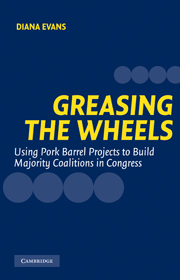Book contents
- Frontmatter
- Contents
- List of Tables and Figures
- Acknowledgments
- 1 Introduction
- 2 Pork Barrel Politics and General Interest Legislation
- 3 Who Calls the Shots? The Allocation of Pork Barrel Projects
- 4 Highway Demonstration Projects and Voting on the Federal Highway Program
- 5 Presidential Bargaining with Congress: The NAFTA Bazaar
- 6 Pork Barreling in the Senate: Do Both Parties Do It?
- 7 Conclusions
- References
- Index
6 - Pork Barreling in the Senate: Do Both Parties Do It?
Published online by Cambridge University Press: 18 November 2009
- Frontmatter
- Contents
- List of Tables and Figures
- Acknowledgments
- 1 Introduction
- 2 Pork Barrel Politics and General Interest Legislation
- 3 Who Calls the Shots? The Allocation of Pork Barrel Projects
- 4 Highway Demonstration Projects and Voting on the Federal Highway Program
- 5 Presidential Bargaining with Congress: The NAFTA Bazaar
- 6 Pork Barreling in the Senate: Do Both Parties Do It?
- 7 Conclusions
- References
- Index
Summary
Previous chapters have focused on vote buying in the House of Representatives on three bills between 1986 and 1993, all years of Democratic control. In all of those cases, policy coalition leaders were able to win House members' votes for the leaders' policy preferences by giving out distributive benefits. In this chapter, we shift the focus to the Senate, examining distributive politics first under a Democratic majority, then under Republican control. This allows us to address the two questions posed at the end of Chapter 5: First, do policy coalition leaders in the Senate, like those in the House, use pork barrel benefits to buy votes for general interest legislation? If so, are Republicans as inclined as Democrats to use pork barrel projects as a coalition-building technique?
There is some reason to doubt that either would be the case. With respect to partisan differences, the Democrats, as the party of government, have fewer doubts than Republicans about the legitimacy of using federal resources to solve problems, whether that solution comes from national policy or distributive benefits to their districts. As a consequence, Democrats are more likely to see vote buying with pork barrel projects as a fairly benign practice. On the other hand, Republicans, with their ideological commitment to economy in government and the free market as the best way to sort out problems, could be expected to take a different approach.
- Type
- Chapter
- Information
- Greasing the WheelsUsing Pork Barrel Projects to Build Majority Coalitions in Congress, pp. 162 - 222Publisher: Cambridge University PressPrint publication year: 2004



